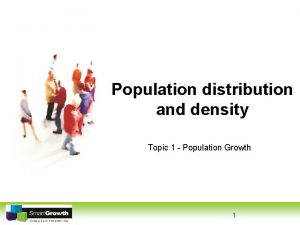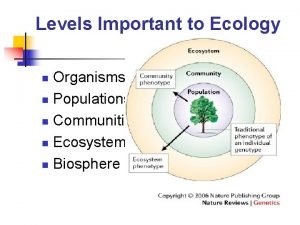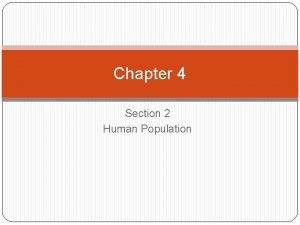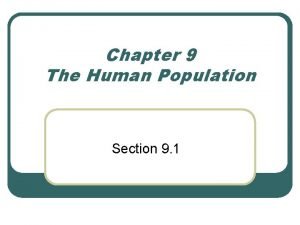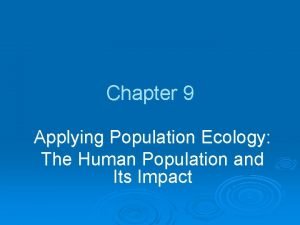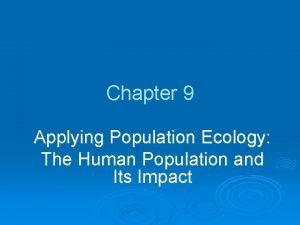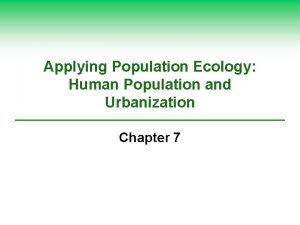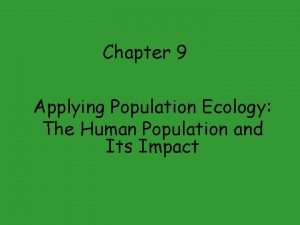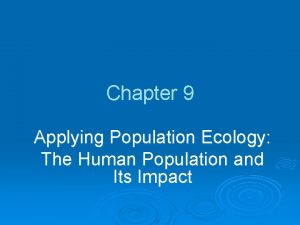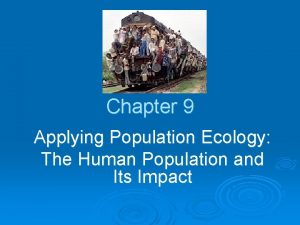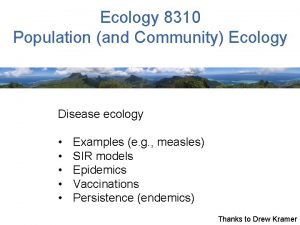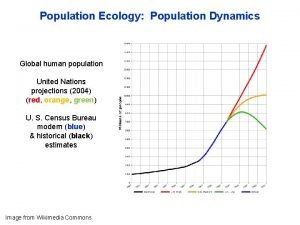Chapter 9 Applying Population Ecology The Human Population
























































- Slides: 56

Chapter 9 Applying Population Ecology: The Human Population and Its Impact

HUMAN POPULATION GROWTH: A BRIEF HISTORY Ø The human population has grown rapidly because of the expansion of agriculture and industrial production and lower death rates from improvements in hygiene and medicine. l l In 2006, the population of developed countries grew exponentially at 0. 1% per year. Developing countries grew (15 times faster at 1. 5% per year.

Where Are We Headed? Ø We do not know how long we can continue increasing the earth’s carrying capacity for humans. l l l There are likely to be between 7. 2 -10. 6 billion people on earth by 2050. 97% of growth in developing countries living in acute poverty. What is the optimum sustainable population of the earth based on the cultural carrying capacity?

Animation: Current and Projected Population Sizes by Region PLAY ANIMATION

Where Are We Headed? Ø U. N. world population projection based on women having an average of 2. 5 (high), 2. 0 (medium), or 1. 5 (low) children.

High 10. 6 Medium Population (billions) Low Medium 8. 9 Low 7. 2 Year

FACTORS AFFECTING HUMAN POPULATION SIZE Ø Population increases because of births and immigration and decreases through deaths and emigration. Ø Instead of using raw numbers, crude birth rates and crude death rates are used (based on total number of births or deaths per 1, 000 people in a population).

FACTORS AFFECTING HUMAN POPULATION SIZE Ø Average crude and birth rates for various groupings of countries in 2006.

Average crude birth rate Average crude death rate 21 World 9 All developed countries All developing countries Developing countries (w/o China) 11 10 23 8 27 9

38 Africa 15 Latin and Central America 21 6 20 Asia 7 Oceania 17 7 United States North America Europe 14 8 10 11

FACTORS AFFECTING HUMAN POPULATION SIZE Ø The world’s 10 most populous countries in 2006 with projections in 2025.

1. 3 billion 1. 5 billion 1. 1 billion 1. 4 billion China India USA Indonesia Brazil Pakistan Bangladesh Russia Nigeria Japan 300 million 349 million 225 million 264 million 187 million 229 million 166 million 229 million 147 million 190 million 142 million 130 million 135 million 199 million 128 million 121 million 2006 2025

Declining Fertility Rates: Fewer Babies per Women Ø The average number of children that a woman bears has dropped sharply. Ø This decline is not low enough to stabilize the world’s population in the near future. l l Replacement-level fertility: the number of children a couple must bear to replace themselves. Total fertility rate (TFR): the average number of children a woman has during her reproductive years.

Declining Fertility Rates: Fewer Babies per Women Ø The replacement level to sustain a population is 2. 0 children. Ø In 2006, the average global Total Fertility Rate was 2. 7 children per woman. l l 1. 6 in developed countries (down from 2. 5 in 1950). 3. 0 in developing countries (down from 6. 5 in 1950).

Case Study: Fertility and Birth Rates in the United States Ø Nearly 2. 9 million people were added to the U. S. in 2006: l l 59% occurred because of births outnumbering deaths. 41% came from illegal and legal immigration.

Case Study: Fertility and Birth Rates in the United States Ø In 2006, the total fertility rate in the United States was slightly > 2. 0

Births per woman Baby boom (1946– 64) Year Replacement Level

Case Study: Fertility and Birth Rates in the United States Ø The baby bust that followed the baby boom was largely due to delayed marriage, contraception, and abortion.

Births per thousand population Demographic transition End of World War II Depression Baby boom Year Baby bust Echo baby boom

47 years Life expectancy 77 years 8% Married women working outside the home 81% 15% High school graduates 83% 10% Homes with flush toilets Homes with electricity Living in suburbs Hourly manufacturing job wage (adjusted for inflation) Homicides per 100, 000 people 98% 2% 99% 10% $3 1. 2 52% 1900 2000 $15 5. 8

Factors Affecting Birth Rates and Fertility Rates Ø The number of children women have is affected by: l l l l The cost of raising and educating them. Availability of pensions. Urbanization. Education and employment opportunities. Infant deaths. Marriage age. Availability of contraception and abortion.

Factors Affecting Death Rates Ø Death rates have declined because of: l l Increased food supplies, better nutrition. Advances in medicine. Improved sanitation and personal hygiene. Safer water supplies. Ø U. S. infant mortality is higher than it could be (ranked 46 th world-wide) due to: l l l Inadequate pre- and post-natal care for poor. Drug addiction. High teenage birth rate.

Case Study: U. S. Immigration Ø Since 1820, the U. S. has admitted almost twice as many immigrants and refugees as all other countries combined.

Number of legal immigrants (thousands) 1907 1914 New laws restrict Immigration Great Depression Year

How Would You Vote? Should legal immigration into the United States (or the country where you live) be reduced? l l l a) Yes: Because of threats of terrorism and the burden on the economy, immigration should be reduced. b) No. Humane efforts should be made to curtail illegal immigration, but our economy needs legal immigrants. c) Other. Explain

POPULATION AGE STRUCTURE Ø The number of people in young, middle, and older age groups determines how fast populations grow or decline. Ø The number of people younger than age 15 is the major factor determining a country’s population growth. Ø Changes in the distribution of a country’s age groups have long-lasting economic and social impacts.

Animation: Examples of Age Structure PLAY ANIMATION

POPULATION AGE STRUCTURE Ø Populations with a large proportion of its people in the preproductive ages 1 -14 have a large potential for rapid population growth.

Male Female Expanding Rapidly Guatemala Nigeria Saudi Arabia Prereproductive ages 0– 14 Male Female Expanding Slowly United States Australia Canada Reproductive ages 15– 44 Male Female Stable Spain Portugal Greece Female Male Declining Germany Bulgaria Italy Postreproductive ages 45– 85+

POPULATION AGE STRUCTURE Ø 32% of the people in developing countries were under 15 years old in 2006 versus only 17% in developed countries.

Developed Countries Female Age Male Population (millions)

Developing Countries Female Age Male Population (millions)

POPULATION AGE STRUCTURE Ø Today, baby boomers make up nearly half of all adult Americans and dominate the populations demand for goods and services.

Females 1955 Males Females 1985 Age Age Males Females 2015 Males Females 2035 Males

Animation: U. S. Age Structure PLAY ANIMATION

POPULATION AGE STRUCTURE Ø About 14% of the world’s population live in countries with stabilizing or declining populations. Ø Rapid population decline can lead to longlasting economic and social problems. Ø Death from AIDS can disrupt a country’s social and economic structure by removing significant numbers of young adults. Ø Global again may help promote peace.

POPULATION AGE STRUCTURE Ø Age structure predictions based on a medium fertility projection. Ø The cost of an aging population will strain the global economy.

Age Distribution (%) Year Under age 15 Age 60 or over Age 80 or over

Video: Bonus For A Baby PLAY VIDEO

POPULATION AGE STRUCTURE Ø Some problems with rapid population decline.

• Can threaten economic growth • Less government revenues with fewer workers • Less entrepreneurship and new business formation • Less likelihood for new technology development • Increasing public deficits to fund higher pension and healthcare costs

SOLUTIONS: INFLUENCING POPULATION SIZE Ø Demographic Transition: As countries become economically developed, their birth and death rates tend to decline. l l l Preindustrial stage: little population growth due to high infant mortality. Transitional stage: industrialization begins, death rates drops and birth rates remain high. Industrial stage: birth rate drops and approaches death rate.

Animation: Demographic Transition Model PLAY ANIMATION

SOLUTIONS: INFLUENCING POPULATION SIZE Ø Generalized model of demographic transition. l Some developing countries may have difficulty making the demographic transition.

Stage 1 Preindustrial Stage 2 Transitional Stage 3 Industrial Stage 4 Postindustrial Relative population size Birth rate and death rate (number per 1, 00 per year) High Birth rate Death rate Low Total population Increasing Very high Decreasing Low Growth rate over time Zero Negative Low

SOLUTIONS: INFLUENCING POPULATION SIZE Ø Family planning has been a major factor in reducing the number of births and abortions throughout most of the world. Ø Women tend to have fewer children if they are: l l l Educated. Hold a paying job outside the home. Do not have their human right suppressed.

SOLUTIONS: INFLUENCING POPULATION SIZE Ø The best way to slow population growth is a combination of: l l l Investing in family planning. Reducing poverty. Elevating the status of women.

SLOWING POPULATION GROWTH IN INDIA AND CHINA Ø For more than five decades, India has tried to control its population growth with only modest success. Ø Since 1970, China has used a governmentenforced program to cut its birth rate in half and sharply reduce its fertility rate.

Percentage of world population Population 17% Illiteracy (% of adults) Infant mortality rate 47% 17% Population under age 15 (%) Total fertility rate 36% 20% 1. 6% 0. 6% 2. 9 children per women (down from 5. 3 in 1970) 1. 6 children per women (down from 5. 7 in 1972) 58 27 62 years 70 years Life expectancy Percentage living below $2 per day GDP PPP per capita 20% 1. 1 billion 1. 3 billion 1. 4 billion 1. 6 billion Population (2050) (estimated) Population growth rate (%) India China 80 47 $3, 120 $5, 890

India’s Failed Family Planning Program Ø Poor planning. Ø Bureaucratic inefficiency. Ø Low status of women. Ø Extreme poverty. Ø Lack of administrative financial support. Ø Disagreement over the best ways to slow population growth.

China’s Family Planning Program Ø Currently, China’s TFR is 1. 6 children per women. Ø China has moved 300 million people out of poverty. Ø Problems: l l l Strong male preference leads to gender imbalance. Average population age is increasing. Not enough resource to support population.

HUMAN ASPECTS ON NATURAL SYSTEMS Ø Excluding Antarctica, human activities have affect about 83% of the earths land surface.

Natural Systems Human. Dominated Systems Complexity Biologically diverse Biologically simplified Energy source Renewable solar energy Mostly nonrenewable fossil fuel energy Property Waste production Little, if any Nutrients Recycled Net primary productivity Shared among many species High Often lost or wasted Used, destroyed, or degraded to support human activities

HUMAN ASPECTS ON NATURAL SYSTEMS Ø We have used technology to alter much of the rest of nature in ways that threaten the survival of many other species and could reduce the quality of life for our own species.

Natural Capital Degradation Altering Nature to Meet Our Needs Reduction of biodiversity Increasing use of the earth's net primary productivity Increasing genetic resistance of pest species and disease-causing bacteria Elimination of many natural predators Deliberate or accidental introduction of potentially harmful species into communities Using some renewable resources faster than they can be replenished Interfering with the earth's chemical cycling and energy flow processes Relying mostly on polluting fossil fuels Fig. 9 -17, p. 188

Animation: Resources Depletion and Degradation PLAY ANIMATION
 Chapter 4 section 1 population dynamics study guide
Chapter 4 section 1 population dynamics study guide Chapter 4 population ecology section 1 population dynamics
Chapter 4 population ecology section 1 population dynamics Population ecology section 1 population dynamics answer key
Population ecology section 1 population dynamics answer key Population ecology section 1 population dynamics
Population ecology section 1 population dynamics Chapter 53 population ecology
Chapter 53 population ecology Equilibrial life history
Equilibrial life history Ecology
Ecology Chapter 53 population ecology
Chapter 53 population ecology Section 1 population dynamics answer key
Section 1 population dynamics answer key Chapter 53 population ecology
Chapter 53 population ecology Population ecology example
Population ecology example Exponential growth equation ecology
Exponential growth equation ecology 52
52 Population vs community ecology
Population vs community ecology Concept 3 population ecology
Concept 3 population ecology Survivorship curve def
Survivorship curve def What is uniform dispersion
What is uniform dispersion Population characteristics ecology
Population characteristics ecology What is population ecology
What is population ecology Population definition ecology
Population definition ecology Population distribution
Population distribution Population ecology
Population ecology Perceptual region definition
Perceptual region definition The geometric arrangement of objects in space
The geometric arrangement of objects in space Ecology of human performance model
Ecology of human performance model Human ecology
Human ecology Human ecology
Human ecology Chapter 4 section 2 human population answer key
Chapter 4 section 2 human population answer key Chapter 9 the human population section 1
Chapter 9 the human population section 1 Chapter 12 lesson 2 applying mendels principles
Chapter 12 lesson 2 applying mendels principles Applying mendel's principles
Applying mendel's principles Chapter 12 lesson 2 applying mendel's principles
Chapter 12 lesson 2 applying mendel's principles Chapter 33 applying paints and enamels
Chapter 33 applying paints and enamels Chapter 12 lesson 2 applying mendels principles
Chapter 12 lesson 2 applying mendels principles Chapter 17:2 performing cardiopulmonary resuscitation
Chapter 17:2 performing cardiopulmonary resuscitation Examples of social learning theory in healthcare
Examples of social learning theory in healthcare Human needs and human development
Human needs and human development Chapter 8 human needs and human development
Chapter 8 human needs and human development Chapter 52 an introduction to ecology and the biosphere
Chapter 52 an introduction to ecology and the biosphere Chapter 3 section 1 community ecology
Chapter 3 section 1 community ecology Chapter 56 conservation biology and restoration ecology
Chapter 56 conservation biology and restoration ecology Phosphorus cycle pearson education
Phosphorus cycle pearson education Chapter 54: community ecology answer key
Chapter 54: community ecology answer key Chapter 52 an introduction to ecology and the biosphere
Chapter 52 an introduction to ecology and the biosphere 5 evolution and community ecology
5 evolution and community ecology Principles of ecology section 3 cycling of matter
Principles of ecology section 3 cycling of matter Chapter 2 principles of ecology test answers
Chapter 2 principles of ecology test answers Principles of ecology chapter 2
Principles of ecology chapter 2 Biological disturbance
Biological disturbance Chapter 55 ecosystems and restoration ecology
Chapter 55 ecosystems and restoration ecology Chapter 5 evolution and community ecology
Chapter 5 evolution and community ecology Chapter 5 evolution and community ecology
Chapter 5 evolution and community ecology Principles of ecology chapter 2 section 1 answer key
Principles of ecology chapter 2 section 1 answer key Chapter 54 community ecology
Chapter 54 community ecology Hình ảnh bộ gõ cơ thể búng tay
Hình ảnh bộ gõ cơ thể búng tay Bổ thể
Bổ thể




















